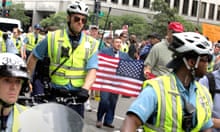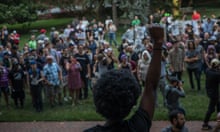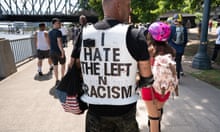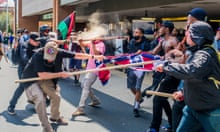Donald Trump has once again defended far-right protesters at the Charlottesville rally, saying they were not all neo-Nazis and white supremacists and laying the blame for the violence equally on what he called the “alt-left”.
The remarks – made during a rowdy press conference in the lobby of Trump Tower in New York – were Trump’s latest switch in stance since Saturday, when the civil rights activist Heather Heyer died after a white nationalist allegedly drove his car into a crowd in the Virginian city.
The US president was fiercely criticised for failing to condemn white supremacists in his initial response to Charlottesville, when he blamed the violence “on many sides”. On Monday, after a chorus of disapproval, he gave an apparently reluctant statement denouncing racism as evil.
Quick GuideWhat happened at the Charlottesville protests?
Show
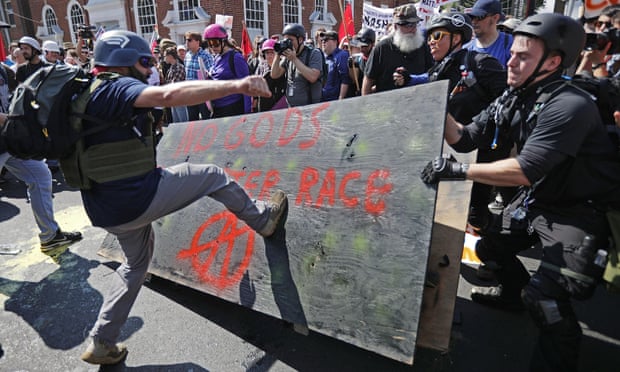
What happened in Charlottesville on 12 August?
White nationalists gathered in Charlottesville, Virginia, to protest against a plan to remove a statue of Robert E Lee, the Confederacy’s top general in the American civil war.
Demonstrators chanted racist statements, carried antisemitic placards and held torches during the “Unite the Right” rally, which was organised by white nationalist Jason Kessler.
The march was met by anti-fascist demonstrators, and some skirmishes broke out before James Fields, 20, allegedly ploughed a car into a group of counter-demonstrators.
Civil rights activist Heather Heyer, 32, died and others were injured. Fields has been charged with murder.
But on Tuesday he reverted to drawing a moral equivalency between the far right and the counter-demonstrators.
“I’m not putting anybody on a moral plane,” he said. “You had a group on one side and group on the other and they came at each other with clubs – there is another side, you can call them the left, that came violently attacking the other group. You had people that were very fine people on both sides.
“Not all those people were neo-Nazis, not all those people were white supremacists. Many of those people were there to protest the taking down of the statue of Robert E Lee. So this week, it is Robert E Lee. I noticed that Stonewall Jackson is coming down. I wonder, is it George Washington next week? And is it Thomas Jefferson the week after? You know, you really do have to ask yourself, where does it stop?”
While all four men were slaveholders, neither Washington nor Jefferson rebelled against the US in an attempt to protect the institution of slavery from federal interference.
Trump declined to attack the so-called alt-right and sparred with reporters about what he termed the “alt-left”.
He urged reporters to define the “alt-right” to him and criticized the “alt-left” for “charging at people without a permit”. The counter-demonstrators “were very, very violent”, he said.
The president insisted to the assembled press that he knew more about the events in Charlottesville because he “had watched this very closely, much more closely than you people watched it”.
Trump added: “You had many people in that group other than neo-Nazis and white nationalists and the press has treated them absolutely unfairly.”
He did condemn James Alex Fields Jr, the man who drove a car into counter-demonstrators, saying he “is a disgrace to himself, his family and his country” and calling him “a murderer”.
The president’s remarks were, according to senior aides who spoke anonymously to CNN and NBC, not planned and surprised members of his staff who had hoped he would stick to talking about infrastructure.
He also fired back at media criticism of his initial response to the violence in Charlottesville on Saturday, when he condemned “hatred, bigotry and violence on many sides” rather than explicitly calling out neo-Nazis and white supremacists.
Trump said: “I wanted to make sure that what I said was correct, not make a quick statement. The statement I made on Saturday was a fine statement.”
The statement was widely criticized by lawmakers from both parties, including senior Republicans who were quick to describe the events as an act of domestic terrorism.
Trump, who said “before I make a statement I need the facts”, has long been prone to weighing in on breaking news events without the full information. In June, he condemned what he called “a terrorist attack” in the Philippines. The attack was actually a failed attempt to rob a casino in Manila.
In addition to his comments about Charlottesville, the president also weighed in on White House intrigue and seemed to throw into doubt the future of his top aide, Steve Bannon.
Although he said Bannon was “not a racist” and “I like Mr Bannon, he’s a friend of mine”, Trump did not offer any guarantees of job security to the former editor of the Breitbart news organisation. “We’ll see what happens,” Trump said of Bannon’s continued employment at the White House.
The event was intended to host an announcement of an executive order to speed the infrastructure permitting process. Trump stood flanked by the chair of the National Economic Council, Gary Cohn, and the treasury secretary, Steven Mnuchin, on one side and by the secretary of transportation, Elaine Chao, on the other. Both Cohn and Mnuchin are Jewish and Chao is Asian American.
The new chief of staff, John Kelly, stood off to the side, where he was photographed with his arms folded, holding his head down as he stared blankly at the floor.
John Kelly during the President's Q and A at Trump Tower pic.twitter.com/vxR3hTUqe3
— Kristin Donnelly (@kristindonnelly) August 15, 2017
The event was cacophonous as shouted questions and irritated answers bounced off the marbled foyer outside of the golden elevators of Trump Tower, the scene of many memorable remarks by Trump, including his campaign announcement on 16 June 2015, when he claimed the Mexican government was deliberately sending criminals and rapists into the US.
Trump’s remarks on Tuesday met immediate criticism from both parties. Senator Orrin Hatch of Utah, the most senior Republican on Capitol Hill, reprised remarks about his brother who died in the second world war.
“I was just eight years old when my older brother Jesse was killed in world war two,” Hatch wrote on Instagram. “As I said on Saturday, Jesse didn’t give his life fighting Hitler for Nazi ideas to go unchallenged here at home. I will never hesitate to speak out against hate – whenever and wherever I see it.”
Senator Marco Rubio of Florida also criticized Trump’s remarks. The former presidential candidate tweeted: “The organizers of events which inspired & led to #charlottesvilleterroristattack are 100% to blame for a number of reasons.”
He went on to note: “Mr President,you can’t allow #WhiteSupremacists to share only part of blame. They support idea which cost nation & world so much pain.” And he added: “the #WhiteSupremacy groups will see being assigned only 50% of blame as a win. We can not allow this old evil to be resurrected.”
The House speaker, Paul Ryan, weighed in on Twitter as well, but did not directly mention Trump’s comments: “We must be clear. White supremacy is repulsive. This bigotry is counter to all this country stands for. There can be no moral ambiguity.”
On the left, the Democratic senator Brian Schatz of Hawaii tweeted: “As a Jew, as an American, as a human, words cannot express my disgust and disappointment. This is not my President.”
Trump’s press conference did draw praise from David Duke, the former grand wizard of the Ku Klux Klan, who was one of the protesters in Charlottesville on Saturday. Duke tweeted:
Thank you President Trump for your honesty & courage to tell the truth about #Charlottesville & condemn the leftist terrorists in BLM/Antifa https://t.co/tTESdV4LP0
— David Duke (@DrDavidDuke) August 15, 2017
At the site of Heyer’s death in downtown Charlottesville, mounds of flowers and chalked messages of remembrance fanned out on the road. A lone trumpeter played a sombre tune, as word of Trump’s comments spread among those who had gathered to mourn. Rather than a sense of disappointment, many here had come to expect such divisive, off the cuff remarks.
Diane Townes, a 62-year-old African American working in education, said the comments were another example of Trump “shaming the victims”.
“Pouting and blaming is not the way to show an example to young people,” she said. “He opened the gateway to this with his own gestures during the campaign.”
Her son Mike Townes had heard the comments on the radio minutes before arriving at the memorial site.
“I’m actually glad he’s saying it,” Townes said. “It is showing this country who he truly is. He represents the people who came to my community as supremacists. David Duke was right about him.”
Eric Gilchrist, another mourner at the memorial, said: “We know that he is selfish and vain, but now I worry he is a sociopath, too. He needs to leave office.”

